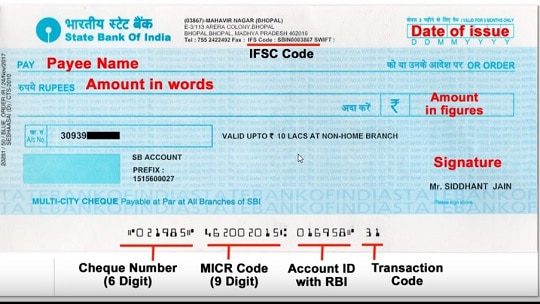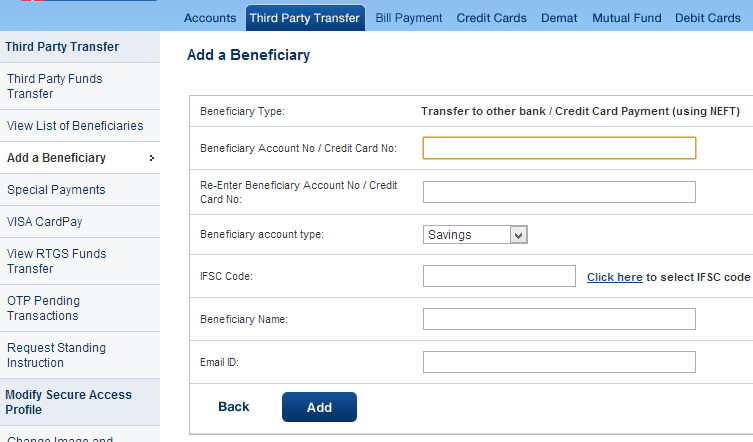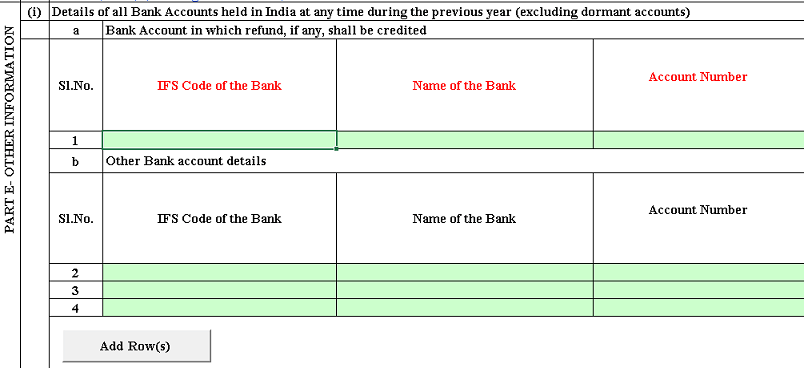IFSC or Indian Financial System Code is used to identify each branch of a bank in India with a unique identification number. The code is used by all the Indian banks that participate in the NEFT, RTGS, IMPS payment settlement systems. You can find the IFSC code on the cheque leaf. You also need to specify IFSC Code for your bank accounts in ITR. This article talks about the IFSC Code. What is IFSC Code? How to find IFSC code of your bank branch? Structure of IFSC Code? Add Beneficiary Details, IFSC Code for NEFT, RTGS, IMPS? How does the IFSC code differ from MICR Code and SWIFT Code?
Table of Contents
What is IFSC Code?
IFSC or Indian Financial System Code is a special 11 digit code given to every bank branch in India. All the accounts in the same branch will have the same IFSC Code. For example, the IFSC code of SBI Main branch in Kolkata is given the code SBIN0000001. When a fund transfer is initiated through NEFT, RTGS or IMPS, he has to provide the bank details such as bank name, branch, account number and the IFSC code of the person to whom money has to be transferred. IFSC Code
- Helps to identify the specific Branch of the Bank
- Eliminates errors in the process of fund transfer
One also has to report the IFSC code in the bank details in the Income Tax Form.
All the accounts in the same branch will have the same IFSC Code. To transfer money to a specific bank account one needs the Bank Account Number and IFSC code. It’s like to find a flat in the apartment you need the apartment address (equivalent to branch address) and the flat number(like an account number)
The RBI is the only authority empowered with generating and allotting IFSC to various bank branches. The RBI maintains a record of IFSC Codes for each bank and branch in India offering online fund transfer facility to the consumers.
How to find IFSC code of your bank branch?
You can find IFSC code a bank branch
- On the chequebook or passbook given by the bank. All Cheques now follow CTS 10 and have bank branch details and IFSC code on the top of the cheque leaf, as shown in the image below.
- You can find IFSC codes on RBI’s official website as well. It is mentioned with the list of banks participating in the RTGS/NEFT network.
- You can find IFSC code on your bank website or call your bank or visit the bank branch.
- Apart from the above, third-party websites like economic times helps you find the required information.
You can find the IFSC code of your bank branch on the cheque leaf.

How to Fill a cheque
What is the Structure of IFSC Code?
IFS Code is an 11 digit code, which contains numerals and alphabets both Ex: SBIN0004384
- The initial four codes represent the bank Ex: SBIN
- Zero is the fifth digit- it is kept for future us as per RBI instructions
- The last 6 digits represent the bank branch code :
- 004384 – Branch Code (Dwarka, Sector 10, New- Delhi)
Other examples
| SBI New Delhi IFSC Code | ICICI Karnataka IFSC Code | Axis Maharastra IFSC Code | HDFC West Bengal IFSC Code | |
| IFSC Code | SBIN0001537 | ICIC0006561 | UTIB0000373 | HDFC0001015 |
| Bank | SBI Bank (State Bank of India)
|
ICICI Bank | AXIS Bank | HDFC Bank |
| Branch | Connaught Place | Bangalore M.G. Road | Goregaon (East) | Dalhousie |
| District | New Delhi | Bangalore | Greater Mumbai | Kolkata |
| State | Delhi | Karnataka | Maharashtra | West Bengal |
| Branch Address | B 37 By 38, Second Floor, Inner Circle Connaught Circus, New Delhi | 11-C, Mittal Towers, M.G. Road, Bangalore, Karnataka | Manish Chambers, Commercial Complex CTS. 87/A, Sonawala Road | Jardine House – 4, Clive Row, Kolkata |
Add Beneficiary Details, IFSC Code for NEFT, RTGS, IMPS
- You need to first login to your bank website using your login details.
- If the person you want to transfer money to is already added as a beneficiary, then you can proceed ahead with the transfer.
- If not, you need to register him/her as a beneficiary. To register a person as beneficiary select the option “Add Beneficiary”. Add his account number correctly, his branch IFSC code. If you are unaware of his IFSC code, it is easily available on the internet. You might get an OTP to confirm the registration of a beneficiary. If you are using mobile banking, no OTP will be generated. T
- Select the person you want to transfer money to, enter the amount and remarks if any.
- Confirm and verify the details
- The money is now transferred and the accounts will be immediately debited/credited.
- You will receive SMS confirmation along with transaction number for any future reference.

How to use IFSC code in NEFT, RTGS, IMPS
Video on how to add beneficiary for third-party money transfer for IMPS, NEFT and RTGS
The following video shows how to add beneficiary for third-party money transfer such as IMPS, NEFT and RTGS.
The beneficiary gets added in 30 minutes.
Post addition, you can transfer money to any IMPS registered beneficiary as per the limits mentioned specified by the bank for example for HDFC Bank, Rs 25,000 in first 24 hours (Post that, the Third Party Transfer limits will apply)
IFSC Code and ITR
If you file Income Tax Return you need to provide IFSC code of all the bank accounts in which you are the first account holder. You need to also specify one bank account in which you would get a refund if any, as shown in the image below.

Add IFSC code for bank accounts in ITR
How does Bank use IFSC Code?
The third party fund transfer such as NEFT rides on the Structured Financial Messaging Solution (SFMS) which is basically designed for both inter-bank and intra-bank exchange of messages between the bank branches.
All NEFT/RTGS/IMPS messages flow to National Clearing Cell (NCC), Nariman Point, Mumbai (from originating banks through the Hub) for netting and thereafter are segregated and sent to respective banks by NCC for affording the credit to beneficiary’s accounts.
Difference between IFSC code and MICR
The MICR Code is a 9 digit numeric code that uniquely identifies a bank-branch participating in the ECS Credit scheme. MICR is an acronym for Magnetic Ink Character Recognition. MICR code is to make cheque processing more efficient. The MICR Code allotted to a bank branch is printed on the bottom of cheques issued by bank branches. In the image above it is shown in red at the bottom of the cheque.
| IFSC Code | MICR Code |
| Used to facilitate electronic fund transfers between banks | MICR code is to make cheque processing more efficient. |
| IFSC is an 11 character alphanumeric code. | MICR is a 9-digit code. |
| The first four characters indicate the name of the bank. | The first three digits represent the city code where the bank branch is located. |
| Last 6 digits represent the bank branch location. | Last three digits indicate the code of the bank branch. |
Difference between IFSC Code and SWIFT
The purpose of SWIFT codes is to transfer money between banks across countries. A SWIFT code is a universal way of identifying banks throughout the world. SWIFT code stands for ‘Society for Worldwide Interbank Financial Telecommunication’ code. The SWIFT code is an 8 or 11 alphanumeric characters code that uniquely identifies the financial institution.
It is the standard format of Bank Identifier Codes (BIC) which is approved by the International Standard Organization (ISO) and represents a particular bank or bank branch. SWIFT (Society for Worldwide Interbank Financial Telecommunication) is also known as BIC (Business Identifier Codes) and as SWIFT-BIC, BIC code, SWIFT code, ISO 9362.
Table below shows the difference between SWIFT and IFSC code
| SWIFT | IFSC |
| SWIFT Stands for ‘Society for Worldwide Interbank Financial Telecommunication’ | IFSC stands for ‘‘Indian Financial System Code’ |
| for international money transfer | used for domestic money transfer (within India) |
| developed by International Standard Organization (ISO) | developed by Reserve Bank Of India (RBI) |
| Has 8 or 11 characters | IFSC codes contain 11 characters |
Related Articles:
- What are Central Banks,What is RBI? What do they do?
- Difference between NEFT, RTGS, IMPS, UPI
- How Credit Card Number is Verified Online Using CVV2
- How India pays: Cash, Cheque,NEFT,Cards etc
- How to use IMPS to send money instantly
- What is Bank?
- Kinds of Cheques
- Cheque: Clearing Process, CTS 2010



